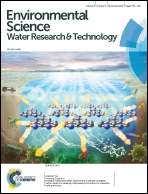Percarbonate oxidation of landfill leachates towards removal of ultraviolet quenchers†
Abstract
Landfill leachates can introduce compounds that absorb ultraviolet (UV) light and thus affect UV disinfection efficiency at municipal wastewater treatment plants when leachates are co-treated. Thus, UV quenchers should be removed or reduced before leachates are sent to a municipal wastewater treatment plant. Herein, a chemical oxidant, sodium percarbonate (SPC, Na2CO3·1.5H2O2), was investigated to oxidize two types of landfill leachates with a focus on UV quenching reduction. The oxidation with 0.2 M SPC for 24 hours reduced Leachate A's concentration of organics by 15.6% and UV254nm absorbance by 43.4%; the values were 15.1% and 7.9%, respectively, for Leachate B. Both the specific ultraviolet absorbance (SUVA254nm) and e280nm absorption coefficient decreased in Leachate A after 0.2 M SPC oxidation, but increased in Leachate B. The organics with size <1 kDa were the major contributor to UV absorbance in both raw leachates, but exhibited different behaviors after SPC oxidation with significantly different contributions to UV absorbance reduction. The maximum chemical oxygen demand (COD) reduction was 5.3 kg m−3 (with 0.05 M SPC) in Leachate A, resulting in a treatment cost of $0.8 per kg of COD removed. SPC oxidation greatly reduced the turbidity of Leachate A (>99%), and increased its bioavailability. The results of this study can be used to develop a cost-effective method for removing UV quenchers from landfill leachates.



 Please wait while we load your content...
Please wait while we load your content...